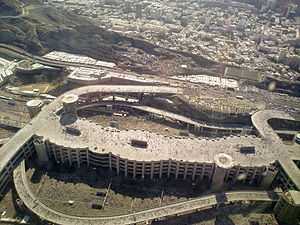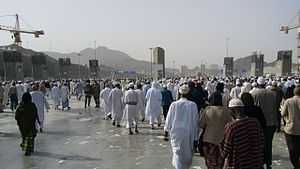Jamaraat Bridge
| Jamaraat Bridge جسر الجمرات | |
|---|---|
| Coordinates | Coordinates: 21°25′17″N 39°52′22″E / 21.42139°N 39.87278°E |
| Carries | Pedestrians |
| Locale |
|



The Jamaraat Bridge (Arabic: جسر الجمرات; transliterated: Jisr Al-Jamaraat) is a pedestrian bridge in Mina, Saudi Arabia near Mecca used by Muslims during the stoning of the devil ritual of the Hajj. The bridge was originally constructed in 1963, and has been expanded several times since then. The purpose of the bridge is to enable pilgrims to throw stones at the three jamrah pillars from either the ground level or from the bridge. The pillars extend up through three openings in the bridge. Until 2006 the bridge had a single tier (i.e. a ground level with one bridge level above).
At certain times, over a million people may gather in the area of the bridge, which has sometimes led to fatal accidents. “Jamaraat” is the plural of jamrah which is the Arabic term for each of the pillars involved in the stoning ritual. It literally means a small piece of stone or a pebble.
New bridge
Following the January 2006 Hajj, the old bridge was demolished and construction began on a new multi-level bridge. The ground and first levels were complete in time for the 2006/2007 Hajj, which passed without incident. Construction on the remaining two levels have been completed since December 2007 1428 AH Hajj.
The new bridge (designed by Dar Al-Handasah and constructed by the Bin Laden Group) contains a wider column-free interior space and expanded jamrah pillars many times longer than their pre-2006 predecessors. Additional ramps and tunnels were built for easier access, and bottlenecks were engineered out. Large canopies are planned to cover each of the three jamrah pillars to protect pilgrims from the desert sun. Ramps are also being built adjacent to the pillars to speed evacuation in the event of an emergency. Additionally, Saudi authorities have issued a fatwa decreeing that the stoning may take place between sunrise and sunset, rather than at the mid-day time that most pilgrims prefer.
Safety issues
During the Hajj, so many people use the bridge that overcrowding can create a hazard. Being the last day of the Hajj, some will bring their luggage.
- On May 23, 1994, a stampede killed at least 270 pilgrims.
- On April 9, 1998, at least 118 pilgrims were trampled to death and 180 injured.[1]
- On March 5, 2001, 35 pilgrims were trampled to death in a stampede.
- On February 11, 2003, the stoning of the Devil ritual claimed 14 pilgrims' lives.[2]
- On February 1, 2004, 251 pilgrims were killed and another 244 injured in a stampede.[3]
- On January 12, 2006, a stampede killed at least 346 pilgrims and injured at least 289 more.
Following the 2004 incident, Saudi authorities embarked on major construction work in and around the Jamaraat Bridge area. Additional access ways, footbridges, and emergency exits were built, and the three cylindrical pillars were replaced with longer and taller oblong walls of concrete to enable more pilgrims simultaneous access. The next year they announced plans for a new, four-story bridge.
See also
Notes
- ^ Deadly Mecca-crush Blamed on Bridge-Bottleneck Sydney Morning Herald, 13 January 2006.
- ^ Minshawi.com
- ^ Hajj ritual sees new safety moves BBC News Tuesday, 10 January 2006, 19:17 GMT.
- ^ Hajj crush police 'not to blame' BBC News Friday, 13 January 2006, 17:34 GMT
- ^ Nine-storey Jamraat Bridge will accommodate 9 million pilgrims per day Saudi Arabi Information Resource 04/02/2004.
As Hajj Begins, More Changes and Challenges In Store altmuslim.com, 13 December 2006
References
- ↑ BBC News | MIDDLE EAST | Saudis identifying nationalities of 118 dead pilgrims
- ↑ BBC NEWS | Middle East | Fourteen killed in Hajj stampede
- ↑ BBC NEWS | Middle East | Hundreds killed in Hajj stampede
External links
| Wikimedia Commons has media related to Jamarat Bridge. |
- Study of the Jamarat Bridge Crowd Dynamics Ltd. - International Crowd Safety Consultants, 24 June 2006.
- Satellite photo of the Jamaraat Bridge taken during the 2003 Hajj — GlobalSecurity.org